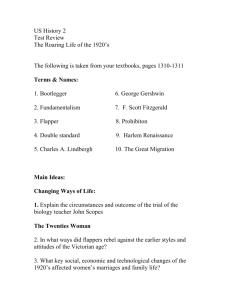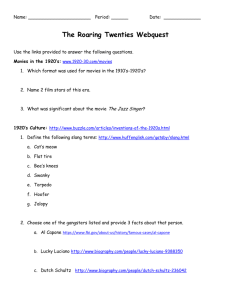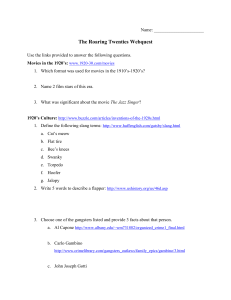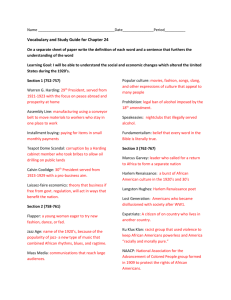1920s - Persinski's History Class
advertisement
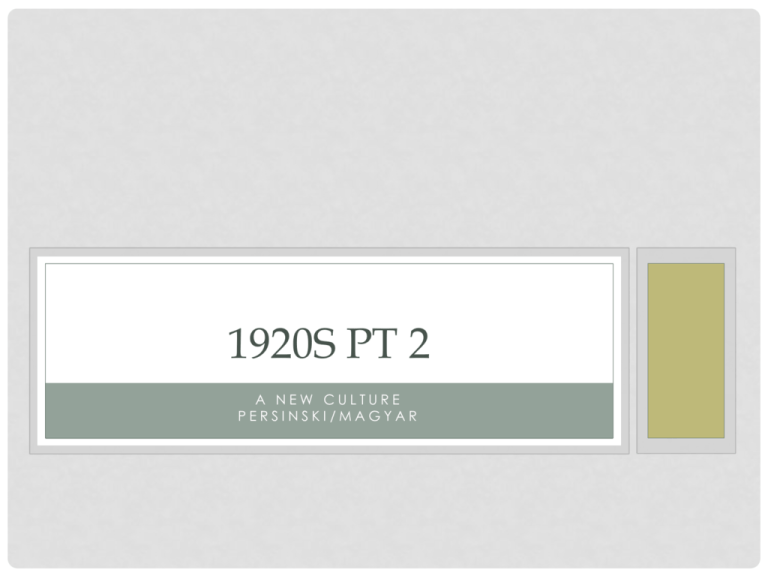
1920S PT 2 A NEW CULTURE PERSINSKI/MAGYAR STANDARD 6 The student will demonstrate an understanding of the conflict between traditionalism and progressivism in the 1920s and the economic collapse and the political response to the economic crisis in the 1930s. Why learn this? • To understand the consequences of economic cycles and to make informed economic choices and political decisions about government policies. STANDARD 6.1 Explain the impact of the changes in the 1920s on the economy, society, and culture, including: - the expansion of mass production techniques, - the invention of new home appliances, - the introduction of the installment plan, - the role of transportation in changing urban life, - the effect of radio and movies in creating a national mass culture, - and the cultural changes exemplified by the Harlem Renaissance. CONSUMER SOCIETY • More disposable income made innovations affordable. • From electric razors to frozen foods and household cleaning supplies to labor saving appliances, Americans used their new income to make life easier. • Higher wages and shorter workdays led to an economic boom as Americans took on a new role as consumers. • For the first time, the U.S. became a consumer society. • In the past, people concentrated on saving. • Now, people began to save less and spend more. • This initially meant growth for the economy, but it also meant peoples’ debts increased while their savings decreased. • American attitudes about debt shifted, as they became confident that they could pay back what they owed at a later time. ADVERTISEMENTS • Advertisements convinced U.S. citizens that they not only wanted, but needed certain products • The mass media worsened the differences between the “have” and “have-nots” by advertising goods that many Americans could not afford to buy • This led to the “buy now, pay later” philosophy that stimulated the economy, but later proved to be harmful to Americans WOMEN In 1920, women finally gained the right to vote with the 19th amendment • The roles and expectations of women changed drastically during this decade. • Economic necessity and advancements in technology led more women than ever into the workforce. Women still faced obstacles: • Generally, single women were hired • The belief was that married women would eventually have children and quit • There was no such thing as maternity leave, so this was typically true • Women were rarely trained for or given positions of leadership • The availability of new appliances led to some social change because women were able to do their house chores more easily: washing machines, electric irons, vacuum cleaners • **This did NOT lead to a significant change in their position in society or in the economy WOMEN • As women’s place in the workforce increased, they began to change their dress and behavior, also. • Women’s hair became shorter, and their hemlines became higher. • They sought clothes that were comfortable and hairstyles that were easier to manage. • Women started going on dates, instead of entertaining men at their homes with a chaperone. **The automobile and “Lover’s Lane” Flappers: • These “New Women” tended to be more rebellious and “funloving” than women in the past. **Although the “flapper” is an icon of the 1920’s, and her freedom helped to change attitudes towards the role of women, most women continued the traditional roles as wife and mother. WOMEN’S FASHION 1900 1865 1920 1915 The Charleston AFRICAN AMERICANS The 1920’s saw great cultural accomplishments within the African-American community. Jazz: • Became a popular form of music after WWI as musical artists from Louisiana and Mississippi brought their talents to the northern cities. • The radio brought jazz music to white audiences. • Jazz created a shared national culture. An increase in black racial pride and awareness led many black intellectuals to write works portraying the daily lives of the working class African-Americans. • Because much of this cultural movement took place in New York City, it became known as the Harlem Renaissance. HARLEM RENAISSANCE The migration of African Americans to segregated neighborhoods in the cities of the north and Midwest brought about a black middle class and a cultural renaissance. • The renaissance brought recognition and pride to black artists, particularly musicians, *but further pointed out their second class citizenship. • Louis Armstrong (1901-1971): a trumpeter and singer from New Orleans; he was one of the most noted jazz musicians in the 1920’s. • Langston Hughes (1902-1967): wrote memorable poetry and short stories about the black experience and reminded black Americans of their African heritage. • Zora Neal Hurston (1891-1960): gained fame for her novel Their Eyes were Watching God • African-Americans began to find a political and social voice through organizations like the NAACP and the United Negro Improvement Association. Harlem’s Cotton Club Jelly Roll Morton Ma Rainey Bessie Smith Louis Armstrong Duke Ellington George Gershwin Cab Calloway MR. BOJANGLES • Bill “Bojangles” Robinson- started in vaudeville, and was on Broadway by 1928. He is most famous for dancing in films with Shirley Temple in the 1930s ADVERTISEMENTS OF THE 1920’S PROJECT Create a commercial advertising a new product of the 1920’s. You must include: • All group members • Some creative element (no reading from papers!) • Costumes • Good acting! ADVERTISEMENTS OF THE 1920’S PROJECT Create a commercial advertising a new product of the 1920’s. Step 1: Choose your product Step 2: Plan your commercial Step 3: Practice with Vimeo App Step 4: Rehearse your commercial (several times!) Step 5: Record your commercial Step 6: Edit your commercial (with Vimeo App) EXAMPLES http://www.youtube.com/watch?v=SAd2wkTe-Uo http://www.youtube.com/watch?v=MH2GWd0vH-0 http://www.youtube.com/watch?v=hzVtIJAOGko STUDENT EXAMPLES https://www.youtube.com/watch?v=2z1AD4hT3xY https://www.youtube.com/watch?v=mStMHsD4cak

